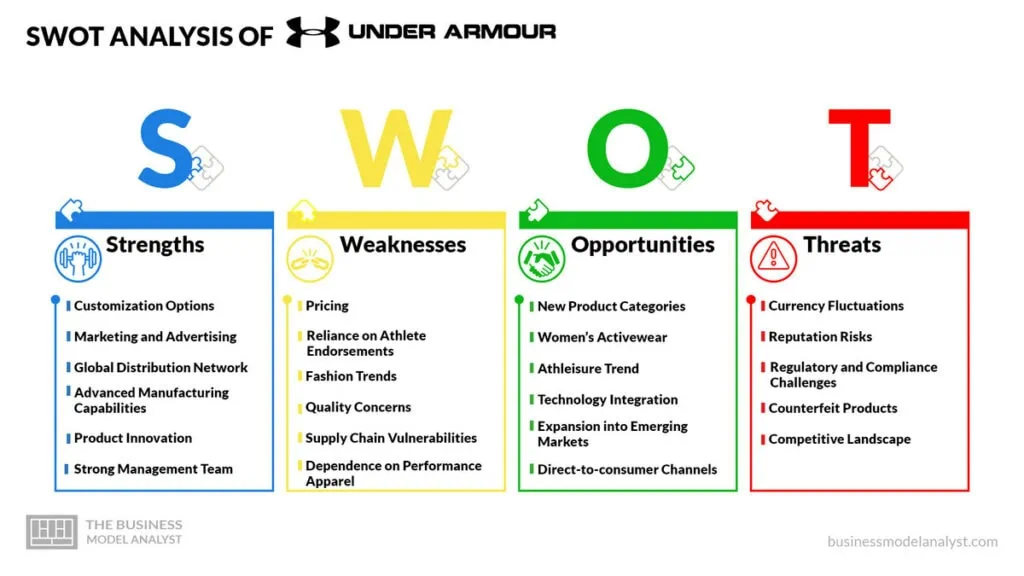Under Armour is a renowned American sportswear and athletic equipment company that has significantly impacted the global market. Founded by Kevin Plank in 1996, the company has become one of the leading brands in the industry, specializing in performance apparel, footwear, and accessories.
The company primarily provides innovative, high-quality products that enhance athletic performance. Its products are designed using cutting-edge technologies and materials to deliver comfort, durability, and style to athletes of all levels. The company has established itself as a trusted brand among professional athletes and sports enthusiasts worldwide.
With its relentless pursuit of excellence, Under Armour has achieved numerous successes. It has secured partnerships with top athletes and teams, allowing the brand to showcase its products on some of the world’s biggest stages.
Additionally, it has expanded its product offerings to include a wide range of sports and activities, catering to the diverse needs of athletes across various disciplines. Under Armour’s contributions to the global market extend beyond its product line. The company has consistently emphasized the importance of innovation and technological advancements in sportswear.
Its commitment to pushing boundaries and challenging the status quo has inspired other companies in the industry to strive for excellence. Furthermore, its dedication to sustainability and social responsibility has helped promote environmentally conscious practices within the sportswear sector.
Under Armour’s journey from humble beginnings to a global powerhouse is a testament to its unwavering commitment to performance, innovation, and quality. Below is a detailed Under Armour SWOT Analysis to understand its strengths, weaknesses, opportunities, and threats.
Contents
Under Armour Strengths
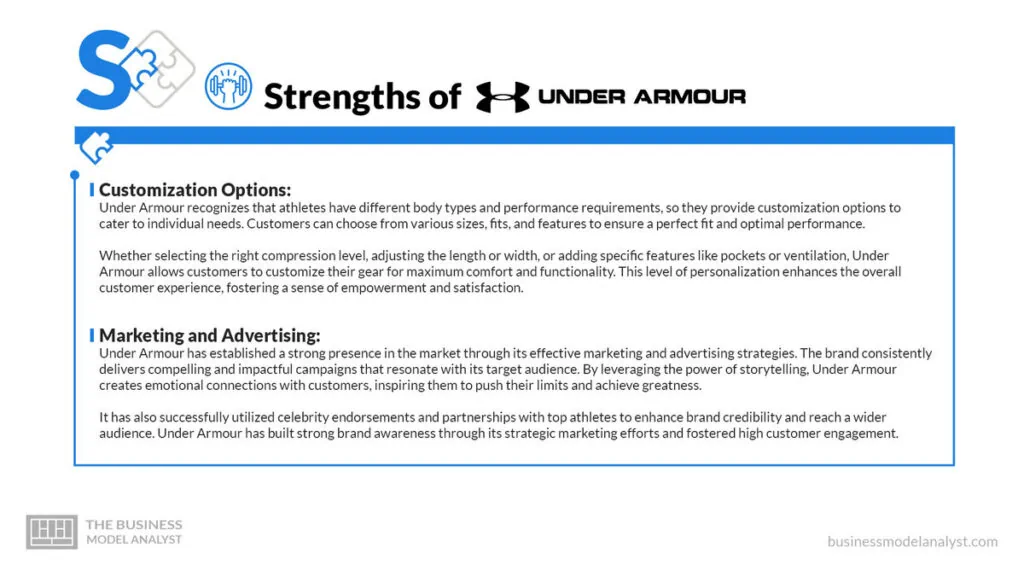
Under Armour’s several key strengths have contributed to its success in the sportswear industry. For instance, it excels in product innovation and has cultivated strong brand loyalty among athletes and sports enthusiasts. Here are more details about the company’s strengths:
Customization Options
Under Armour recognizes that athletes have different body types and performance requirements, so they provide customization options to cater to individual needs. Customers can choose from various sizes, fits, and features to ensure a perfect fit and optimal performance.
Whether selecting the right compression level, adjusting the length or width, or adding specific features like pockets or ventilation, Under Armour allows customers to customize their gear for maximum comfort and functionality. This level of personalization enhances the overall customer experience, fostering a sense of empowerment and satisfaction.
Marketing and Advertising
Under Armour has established a strong presence in the market through its effective marketing and advertising strategies. The brand consistently delivers compelling and impactful campaigns that resonate with its target audience. By leveraging the power of storytelling, Under Armour creates emotional connections with customers, inspiring them to push their limits and achieve greatness.
It has also successfully utilized celebrity endorsements and partnerships with top athletes to enhance brand credibility and reach a wider audience. Under Armour has built strong brand awareness through its strategic marketing efforts and fostered high customer engagement.
Global Distribution Network
Also, the company has strategically built a robust global distribution network, enabling its products to reach customers worldwide. It has partnered with reputable retail partners in brick-and-mortar stores and online platforms to ensure widespread availability and accessibility.
This network includes major sporting goods retailers, department stores, and e-commerce giants, expanding the brand’s reach across diverse markets. Additionally, the brand has invested in its e-commerce platform, providing customers with a direct channel to purchase products and engage with the brand. This vast distribution network drives the brand’s global growth and increases its market share.
Advanced Manufacturing Capabilities
Under Armour’s advanced manufacturing capabilities have been a key strength in delivering high-quality products to its customers. The brand utilizes cutting-edge technologies and processes to ensure efficient and precise production. It can streamline operations, optimize resource utilization, and reduce lead times by leveraging automation and innovative manufacturing techniques.
These advanced capabilities enable the brand to consistently deliver products that meet stringent quality standards while maintaining cost-effectiveness. Integrating advanced manufacturing processes allows Under Armour to adapt quickly to market demands and introduce new products with shorter development cycles.
Product Innovation
Under Armour’s commitment to product innovation is a driving force behind its success in the sportswear industry. It invests heavily in research and development, continuously pushing the boundaries of technology and materials. Through extensive testing and collaboration with athletes, Under Armour identifies gaps in the market and develops innovative solutions to address them.
By introducing new technologies and materials, such as moisture-wicking fabrics, compression garments, and performance-enhancing footwear, the company empowers athletes to excel in their respective sports. This focus on innovation not only differentiates Under Armour from competitors, but also drives the advancement of sportswear, inspiring others in the industry to strive for excellence.
Strong Management Team
Another strength is that the brand benefits from a solid and experienced management team that plays a pivotal role in shaping the company’s strategic direction and driving its growth. The team possesses a deep understanding of the sportswear industry, allowing them to make informed decisions and capitalize on market opportunities.
Their marketing, operations, finance, and product development expertise ensures a well-rounded business management approach. By effectively aligning the efforts of various departments, the management team fosters a culture of collaboration and innovation, enabling Under Armour to stay ahead in a competitive market.
Their leadership and guidance have been instrumental in steering the company toward continued success and maintaining its position as a prominent player in the industry.
Broad Product Portfolio
Under Armour’s broad product portfolio is another key strength that sets the brand apart in the sportswear industry. The company offers a comprehensive range of products, spanning apparel, footwear, and accessories, ensuring athletes and sports enthusiasts can find everything they need in one place.
Whether it’s running, basketball, soccer, or yoga, Under Armour provides specialized gear tailored to the unique requirements of each sport. The brand’s diverse product offerings extend beyond performance gear, encompassing lifestyle apparel and athleisure options that blend style and functionality. This broad product range allows Under Armour to cater to a wide customer base, capturing market segments across different sports, activities, and lifestyles.
Brand Loyalty
Under Armor has a strong and loyal customer base thanks to its dedication to quality, performance, and customer satisfaction. By consistently delivering products that meet high standards, it has gained the trust and loyalty of athletes and sports enthusiasts. The brand’s emphasis on performance-driven designs and innovative technologies has resonated with customers who seek gear that enhances their athletic abilities.
Additionally, Under Armour places great importance on customer satisfaction, striving to provide exceptional service and addressing any concerns promptly. This commitment to meeting and exceeding customer expectations has fostered a sense of loyalty among its consumer base, leading to repeat purchases and positive word-of-mouth recommendations.
Sponsorships
Under Armour’s sponsorship of major sporting events has been instrumental in boosting its visibility and brand recognition worldwide. By aligning itself with prestigious tournaments, championships, and athletic competitions, the brand gains exposure to a vast audience of sports enthusiasts.
These sponsorships provide Under Armour with significant opportunities for product placement, on-field branding, and athlete endorsements, further enhancing its brand presence. The association with high-profile events increases the brand’s reach, solidifies its credibility, and establishes it as a trusted partner in the world of sports.
It also serves as a platform for Under Armour to showcase its latest innovations and technologies, reinforcing its position as a leader in the sportswear industry.
Technological Expertise
Under Armour’s commitment to technological expertise keeps the brand at the forefront of the sportswear industry. The company strongly emphasizes research and development, investing in cutting-edge technologies, and staying ahead of industry trends. Under Armour can develop products that push the boundaries of athletic performance by continuously exploring new materials, manufacturing processes, and innovations.
This technological expertise allows the brand to deliver gear that maximizes comfort, breathability, moisture-wicking, and other key performance attributes. Through its focus on staying at the forefront of technological advancements, Under Armour ensures that its products consistently meet the evolving needs and demands of athletes, solidifying its position as a leader in the market.
Under Armour’s Weaknesses
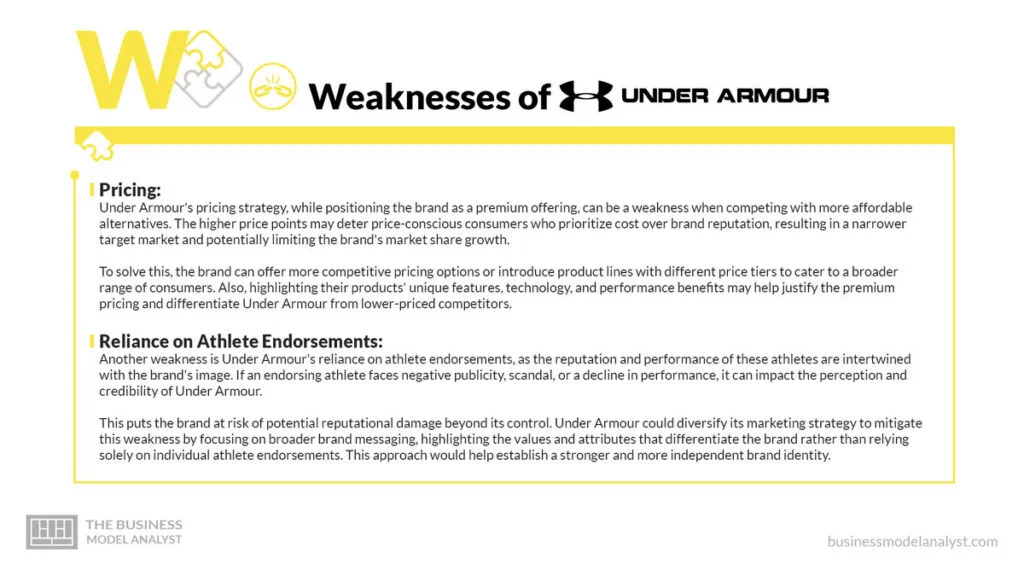
While Under Armour has achieved remarkable success, it also faces certain weaknesses. One weakness is its relatively high pricing compared to some competitors, which may limit its appeal to price-conscious consumers. Below are more weaknesses the company needs to work on:
Pricing
Under Armour’s pricing strategy, while positioning the brand as a premium offering, can be a weakness when competing with more affordable alternatives. The higher price points may deter price-conscious consumers who prioritize cost over brand reputation, resulting in a narrower target market and potentially limiting the brand’s market share growth.
To solve this, the brand can offer more competitive pricing options or introduce product lines with different price tiers to cater to a broader range of consumers. Also, highlighting their products’ unique features, technology, and performance benefits may help justify the premium pricing and differentiate Under Armour from lower-priced competitors.
Reliance on Athlete Endorsements
Another weakness is Under Armour’s reliance on athlete endorsements, as the reputation and performance of these athletes are intertwined with the brand’s image. If an endorsing athlete faces negative publicity, scandal, or a decline in performance, it can impact the perception and credibility of Under Armour.
This puts the brand at risk of potential reputational damage beyond its control. Under Armour could diversify its marketing strategy to mitigate this weakness by focusing on broader brand messaging, highlighting the values and attributes that differentiate the brand rather than relying solely on individual athlete endorsements. This approach would help establish a stronger and more independent brand identity.
Fashion Trends
Under Armour’s focus on performance-driven apparel may present a weakness when staying current with fast-paced fashion trends. Fashion-conscious consumers often prioritize style and aesthetics alongside functionality. If Under Armour fails to adapt and incorporate popular fashion trends into its designs, it may lose appeal among this specific consumer segment.
Under Armour could consider collaborations with fashion designers or influencers to infuse trendier elements into their collections to address this weakness. Additionally, conducting market research and closely monitoring fashion trends can help the brand stay ahead of evolving consumer preferences and ensure its products remain relevant and appealing in the fashion-conscious market.
Quality Concerns
Recently, the brand has encountered quality concerns and criticism related to the durability and longevity of some of its products. Reports of product defects, such as stitching issues, fabric wear, or premature product deterioration, have raised questions about the brand’s overall quality standards. Such concerns can negatively impact customer satisfaction and loyalty.
The brand should prioritize quality control measures throughout its manufacturing processes, conduct thorough product testing, and invest in research and development to improve product durability and longevity. Transparent communication and responsive customer service in addressing quality issues can also help rebuild consumer trust and confidence.
Supply Chain Vulnerabilities
Under Armour’s global operations expose the brand to supply chain vulnerabilities that can impact its ability to meet customer demands. Disruptions in the global supply chain, such as transportation challenges, raw material shortages, or manufacturing delays, can lead to inventory shortages or delays in order fulfillment. These disruptions can harm customer satisfaction and brand reputation.
Under Armour should focus on building a resilient and diversified supply chain, establishing backup suppliers, and implementing contingency plans to mitigate potential disruptions. Enhancing collaboration and communication with suppliers and logistics partners can help proactively manage and address supply chain challenges.
Dependence on Performance Apparel
Finally, Under Armour’s heavy emphasis on performance apparel depends on shifting consumer preferences and fashion trends. The brand may struggle to keep pace if there is a significant shift towards more casual or athleisure-focused styles. It may limit its appeal to consumers seeking versatile, fashion-forward options.
However, Under Armour can diversify its product offerings to include a broader range of athleisure and lifestyle apparel that aligns with current fashion trends. This expansion would help the brand cater to a broader customer base and reduce its vulnerability to fluctuations in consumer preferences within the performance-focused market segment.
Under Armour’s Opportunities
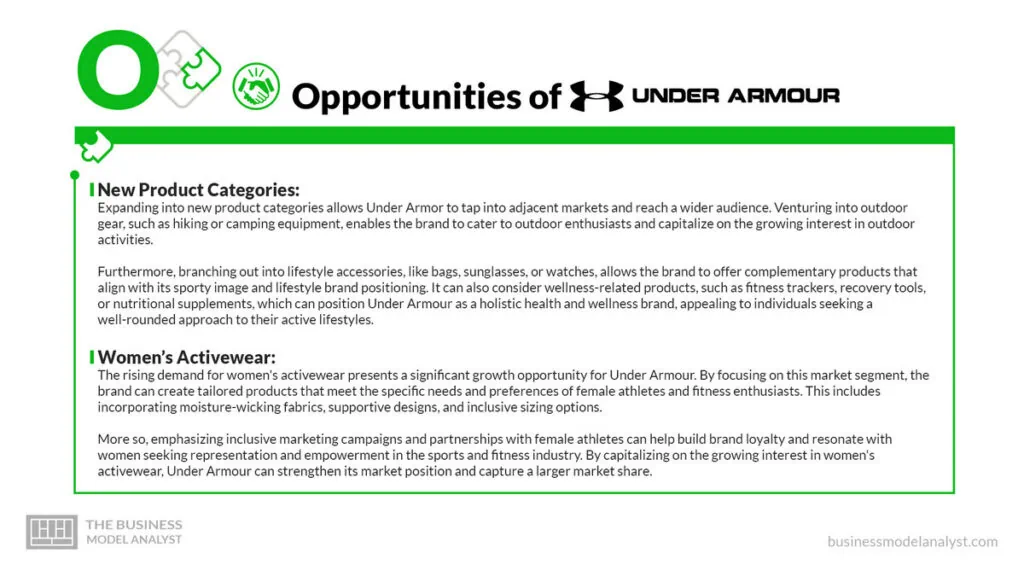
Under Armour has several opportunities to leverage for future growth and success. For instance, the growing global demand for sportswear presents an opportunity for Under Armour to expand its market share internationally and tap into new customer bases. Below is a detailed analysis of the opportunities available for Under Armour:
New Product Categories
Expanding into new product categories allows Under Armor to tap into adjacent markets and reach a wider audience. Venturing into outdoor gear, such as hiking or camping equipment, enables the brand to cater to outdoor enthusiasts and capitalize on the growing interest in outdoor activities.
Furthermore, branching out into lifestyle accessories, like bags, sunglasses, or watches, allows the brand to offer complementary products that align with its sporty image and lifestyle brand positioning. It can also consider wellness-related products, such as fitness trackers, recovery tools, or nutritional supplements, which can position Under Armour as a holistic health and wellness brand, appealing to individuals seeking a well-rounded approach to their active lifestyles.
Women’s Activewear
The rising demand for women’s activewear presents a significant growth opportunity for Under Armour. By focusing on this market segment, the brand can create tailored products that meet the specific needs and preferences of female athletes and fitness enthusiasts. This includes incorporating moisture-wicking fabrics, supportive designs, and inclusive sizing options.
More so, emphasizing inclusive marketing campaigns and partnerships with female athletes can help build brand loyalty and resonate with women seeking representation and empowerment in the sports and fitness industry. By capitalizing on the growing interest in women’s activewear, Under Armour can strengthen its market position and capture a larger market share.
Athleisure Trend
The athleisure trend offers a significant opportunity for Under Armour to expand its product offerings and cater to the evolving needs of consumers seeking both style and functionality. By developing a line of athleisure apparel, the company can tap into the demand for versatile clothing that seamlessly transitions from workouts to everyday wear.
Emphasizing fashionable designs, trendy colors, and innovative fabrics will allow the brand to capture the attention of fashion-conscious consumers who prioritize comfort and style. Leveraging its expertise in performance-driven apparel, Under Armour can position itself as a go-to brand for individuals seeking fashionable athleisure options without compromising on quality or performance.
Technology Integration
Leveraging emerging technologies presents an exciting opportunity for Under Armour to stay at the forefront of the sportswear industry. By integrating wearable devices into their products, such as fitness trackers or smartwatches, Under Armour can offer customers enhanced performance tracking and personalized experiences.
Incorporating smart fabrics with features like moisture management or temperature regulation can further elevate the functionality of their apparel. Similarly, utilizing data analytics to gather insights on customer behavior and preferences can inform product development, marketing strategies, and personalized recommendations, fostering stronger customer relationships.
The company can differentiate itself by embracing technology and providing innovative solutions that enhance athletic performance and customer satisfaction.
Expansion into Emerging Markets
Expanding into global markets presents a significant opportunity for Under Armour to tap into new markets and increase its global footprint. Emerging markets, in particular, offer untapped potential for the brand to establish a strong presence and gain market share. Under Armor can penetrate these markets by tailoring products and marketing strategies to specific cultural preferences and local demands.
Furthermore, this expansion enables the brand to diversify its revenue streams and reduce dependence on any single market. Collaborating with local distributors or forming strategic partnerships can facilitate market entry and accelerate growth in new regions.
Direct-to-consumer Channels
Expanding and optimizing direct-to-consumer channels strengthens Under Armor’s customer relationship and enhances the brand experience. By investing in e-commerce platforms and improving the online shopping experience, Under Armour can reach a broader customer base, including those who prefer the convenience of online shopping.
Besides, company-owned retail stores provide an avenue for immersive brand experiences and personalized customer interactions. With greater control over the sales process, Under Armour can collect valuable customer data, gather insights, and tailor marketing strategies to serve its target audience better. It can also foster brand loyalty, increase sales, and gain a competitive edge in the market.
Under Armour’s Threats
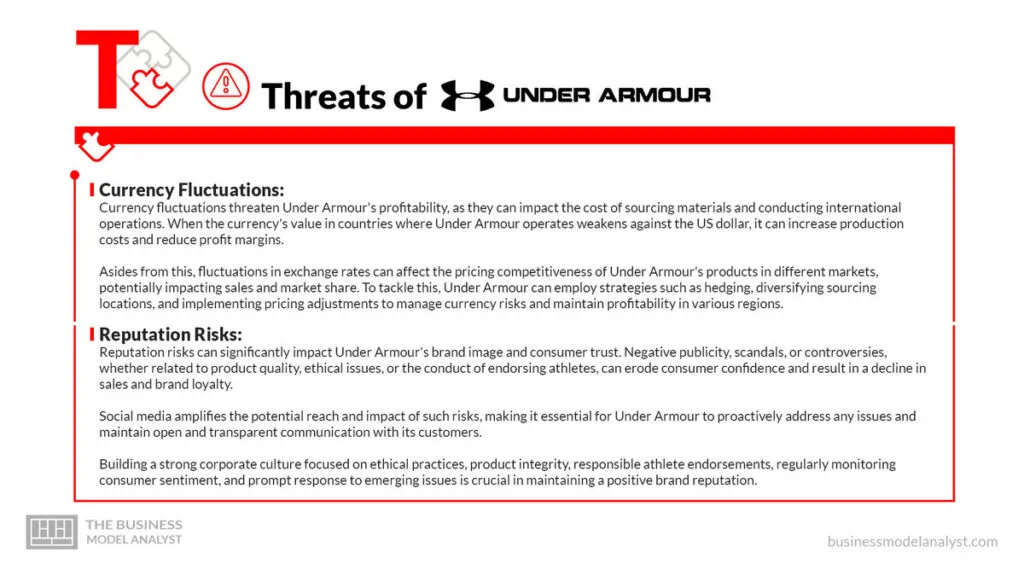
Under Armour faces several threats that could impact its business and market position, such as intense competition from established sportswear brands and emerging industry players. Below are more threats Under Armour should tackle:
Currency Fluctuations
Currency fluctuations threaten Under Armour’s profitability, as they can impact the cost of sourcing materials and conducting international operations. When the currency’s value in countries where Under Armour operates weakens against the US dollar, it can increase production costs and reduce profit margins.
Asides from this, fluctuations in exchange rates can affect the pricing competitiveness of Under Armour’s products in different markets, potentially impacting sales and market share. To tackle this, Under Armour can employ strategies such as hedging, diversifying sourcing locations, and implementing pricing adjustments to manage currency risks and maintain profitability in various regions.
Reputation Risks
Reputation risks can significantly impact Under Armour’s brand image and consumer trust. Negative publicity, scandals, or controversies, whether related to product quality, ethical issues, or the conduct of endorsing athletes, can erode consumer confidence and result in a decline in sales and brand loyalty.
Social media amplifies the potential reach and impact of such risks, making it essential for Under Armour to proactively address any issues and maintain open and transparent communication with its customers.
Building a strong corporate culture focused on ethical practices, product integrity, responsible athlete endorsements, regularly monitoring consumer sentiment, and prompt response to emerging issues is crucial in maintaining a positive brand reputation.
Regulatory and Compliance Challenges
Another threat is regulatory and compliance challenges, particularly in a complex and evolving regulatory landscape. Compliance with labor laws, such as fair wages and working conditions, is crucial to ensure ethical sourcing and manufacturing practices. Meeting environmental standards and sustainable manufacturing requirements can require substantial investments in technologies and processes.
Also, compliance with product safety regulations is essential to protect consumers and avoid potential legal liabilities. Keeping abreast of regulatory changes, maintaining robust compliance programs, and engaging in proactive dialogue with regulatory authorities are key strategies for Under Armour to navigate these challenges effectively.
Counterfeit Products
Counterfeit goods dilute the brand’s reputation and erode customer trust in the authenticity and quality of Under Armour products. Customers may opt for counterfeit items at lower prices, leading to potential revenue losses for the company.
To combat this, Under Armour should invest in robust anti-counterfeiting measures, such as advanced authentication technologies, proactive monitoring of online marketplaces, and collaboration with law enforcement agencies to identify and take legal action against counterfeiters. Educating consumers about the risks of purchasing counterfeit products and emphasizing the value of genuine Under Armour merchandise can also help.
Competitive Landscape
Intense competition is another major threat. Established sportswear brands like Nike and Adidas have a strong foothold in the industry and enjoy significant brand recognition and customer loyalty. They have broad product lines, expansive distribution networks, and substantial marketing budgets, which challenge Under Armour’s market position.
Apart from this, the emergence of new players and smaller, niche sportswear brands that cater to specific market segments can further intensify competition and potentially erode Under Armour’s market share. Under Armour must continue to innovate, differentiate its products, invest in marketing and branding initiatives, and cultivate strong customer relationships to maintain a competitive edge in the market to counter this threat.
Conclusion
In conclusion, Under Armour is a well-established sportswear brand that has made significant contributions to the global market. The company has built a reputation for its high-performance apparel, footwear, and accessories.
It has leveraged its strengths in customization options, marketing and advertising, global distribution, advanced manufacturing capabilities, product innovation, strong management team, broad product portfolio, brand loyalty, sponsorship of major events, and technological expertise to achieve success and establish a strong presence in the industry.
However, the brand also faces several challenges, including pricing, reliance on athlete endorsements, fashion trends, quality concerns, supply chain vulnerabilities, dependence on performance apparel, and various threats such as intense competition, currency fluctuations, reputation risks, regulatory and compliance challenges, counterfeit products, and economic downturns.
Under Armour should capitalize on opportunities such as expansion into new categories, women’s activewear, athleisure trends, international markets, direct-to-consumer channels, and technology integration to thrive in a competitive market while addressing weaknesses and mitigating threats. With a strategic approach and continued focus on innovation, Under Armour can continue to evolve and maintain its position as a leading sportswear brand.


